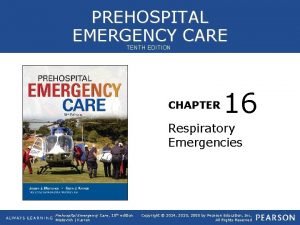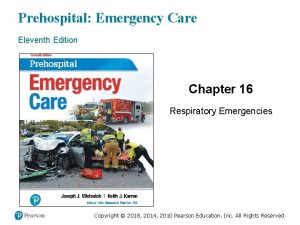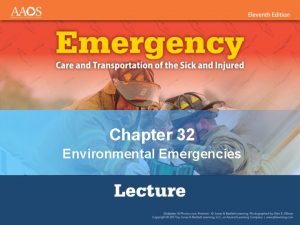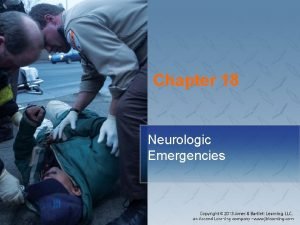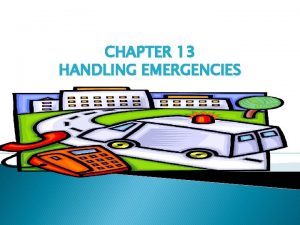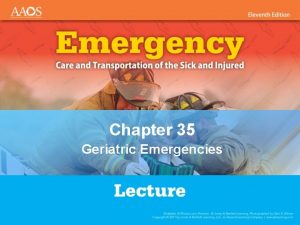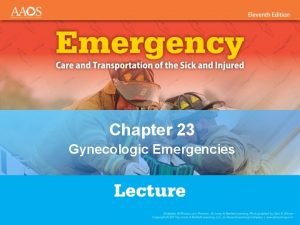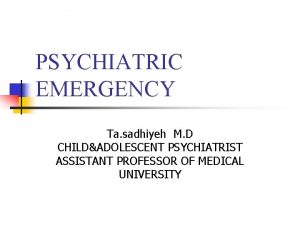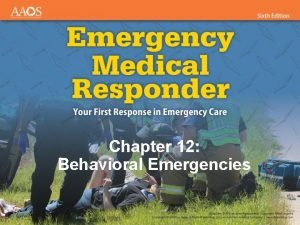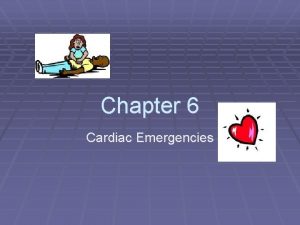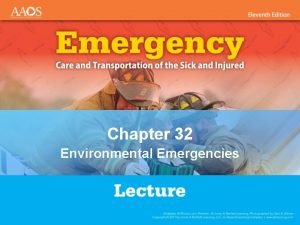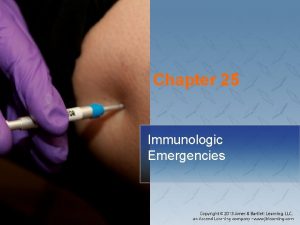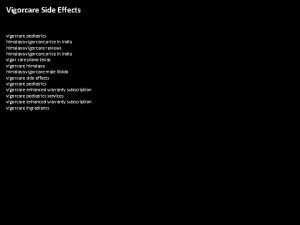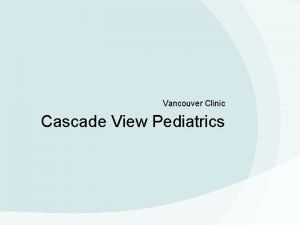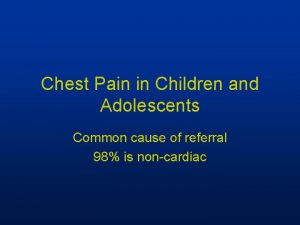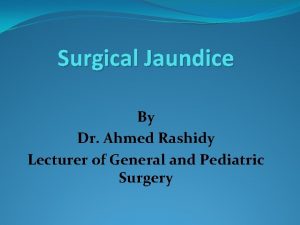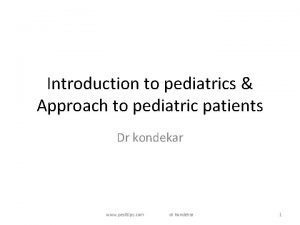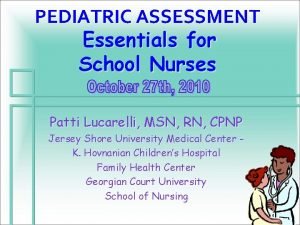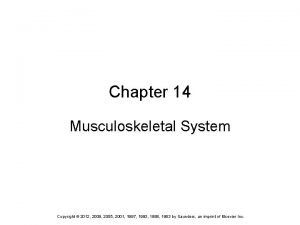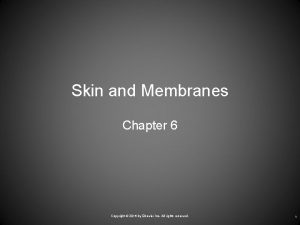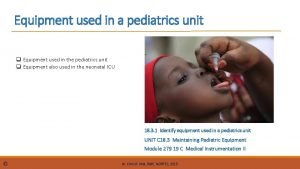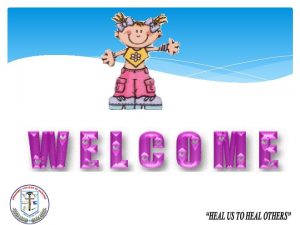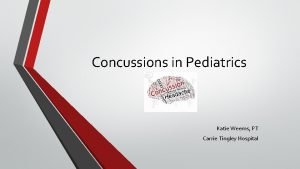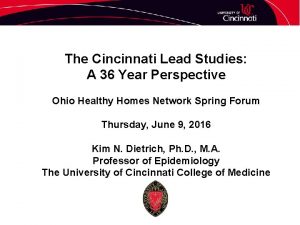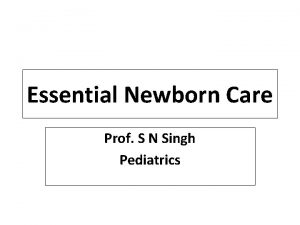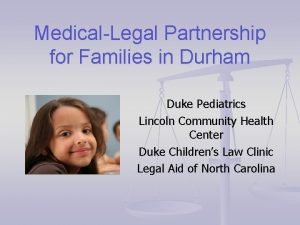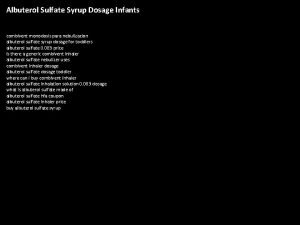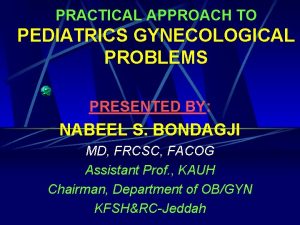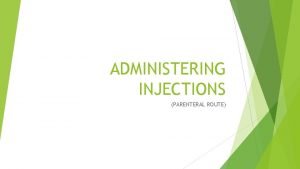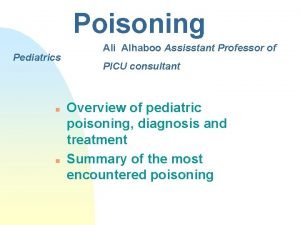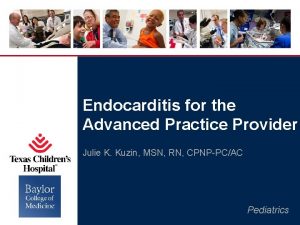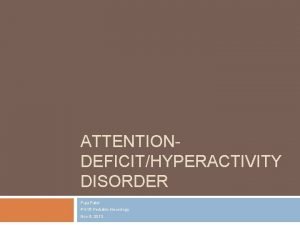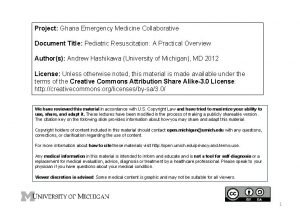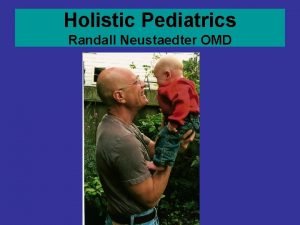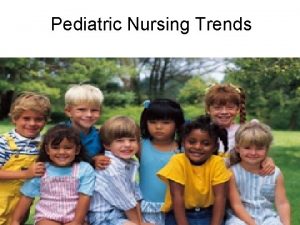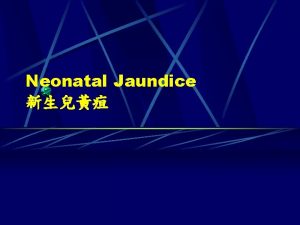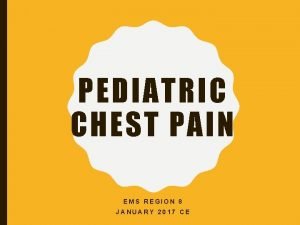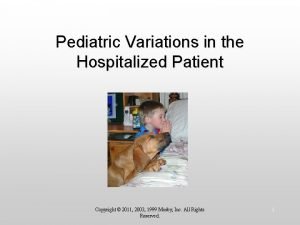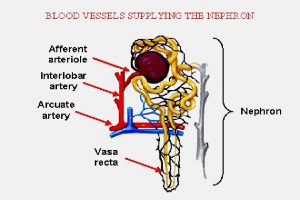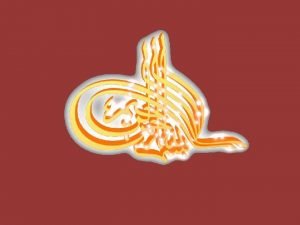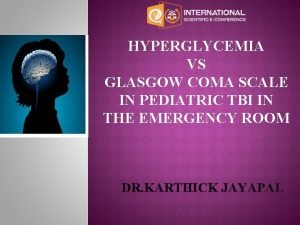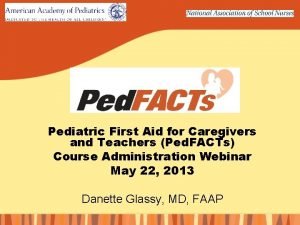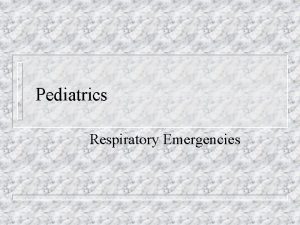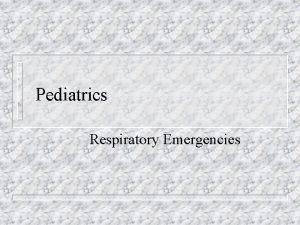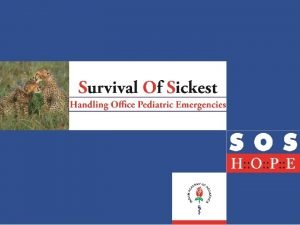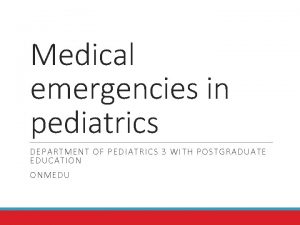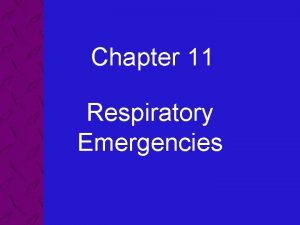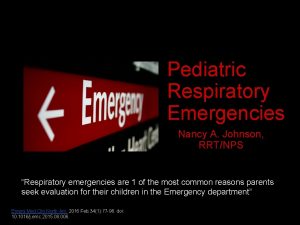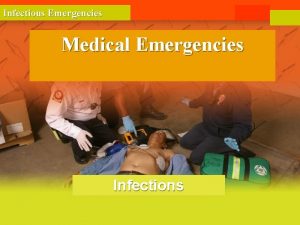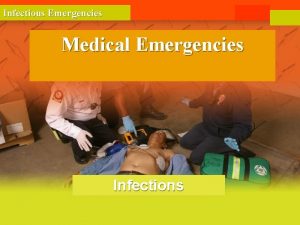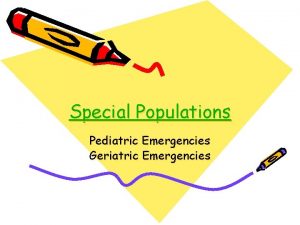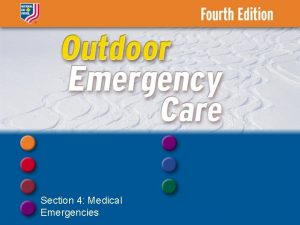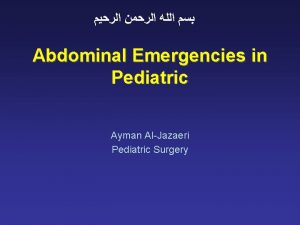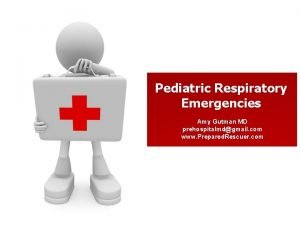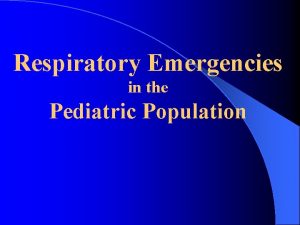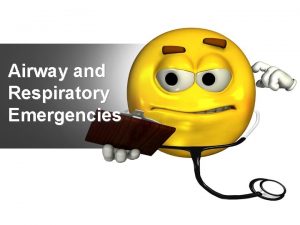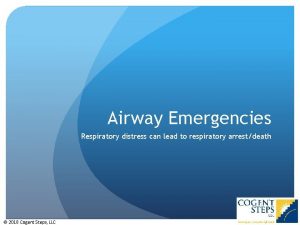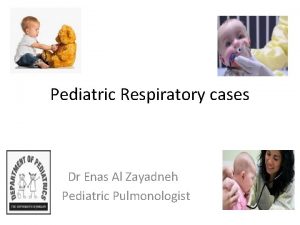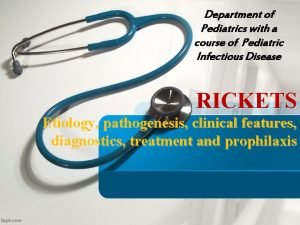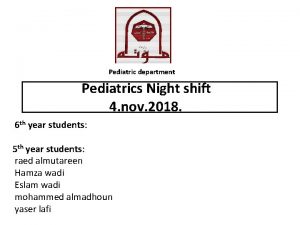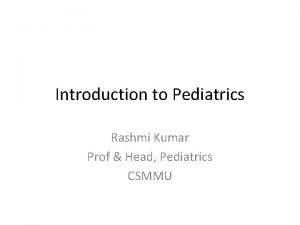Pediatrics Respiratory Emergencies Dr khaysy RASSAVONG Pediatric Department































































- Slides: 63

Pediatrics Respiratory Emergencies Dr. khaysy RASSAVONG Pediatric Department Mahosot Hospital

Respiratory Emergencies n #1 cause of Pediatric hospital admissions u Death during first year of life except for congenital abnormalities u

Respiratory Emergencies Most pediatric cardiac arrest begins as respiratory failure or respiratory arrest

Pediatric Respiratory System n n n Large head, small mandible, small neck Large, posteriorlyplaced tongue High glottic opening Small airways Presence of tonsils, adenoids

Pediatric Respiratory System n n Poor accessory muscle development Less rigid thoracic cage Horizontal ribs, primarily diaphragm breathers Increased metabolic rate, increased O 2 consumption

Pediatric Respiratory System Decrease respiratory reserve + Increased O 2 demand = Increased respiratory failure risk

Respiratory Distress

Respiratory Distress n n Tachycardia (May be bradycardia in neonate) Head bobbing, stridor, prolonged expiration Abdominal breathing Grunting--creates CPAP

Respiratory Emergencies n n n Croup Epiglottitis Asthma Bronchiolitis Foreign body aspiration Bronchopulmonary dysplasia

Laryngotracheobronchitis Croup

Croup: Pathophysiology n n n Viral infection (parainfluenza) Affects larynx, trachea Subglottic edema; Air flow obstruction

Croup: Incidence n n n 6 months to 4 years Males > Females Fall, early winter

Croup: Signs/Symptoms n n n “Cold” progressing to hoarseness, cough Low grade fever Night-time increase in edema with: u Stridor u “Seal bark” cough u Respiratory distress u Cyanosis n Recurs on several nights

Croup: Management n Mild Croup Reassurance u Moist, cool air u

Croup: Management n Severe Croup u Humidified high concentration oxygen u Monitor EKG u IV tko if tolerated u Nebulized racemic epinephrine u Anticipate need to intubate, assist ventilations

Epiglottitis

Epiglottitis: Pathophysiology n n n Bacterial infection (Hemophilus influenza) Affects epiglottis, adjacent pharyngeal tissue Supraglottic edema Complete Airway Obstruction

Epiglottitis: Incidence n n n Children > 4 years old Common in ages 4 - 7 Pedi incidence falling due to Hi. B vaccination Can occur in adults, particularly elderly Incidence in adults is increasing

Epiglottitis: Signs/Symptoms n n n n Rapid onset, severe distress in hours High fever Intense sore throat, difficulty swallowing Drooling Stridor Sits up, leans forward, extends neck slightly One-third present unconscious, in shock

Epiglottitis Respiratory distress+ Sore throat+Drooling = Epiglottitis

Epiglottitis: Management n n High concentration oxygen IV tko, if possible Rapid transport Do not attempt to visualize airway

Epiglottitis Immediate Life Threat Possible Complete Airway Obstruction

Asthma

Asthma: Pathophysiology n Lower airway hypersensitivity to: u Allergies u Infection u Irritants u Emotional stress u Cold u Exercise

Asthma: Pathophysiology Bronchospasm Bronchial Edema Increased Mucus Production

Asthma: Pathophysiology

Asthma: Pathophysiology Cast of airway produced by asthmatic mucus plugs

Asthma: Signs/Symptoms n n Dyspnea Signs of respiratory distress u Nasal flaring u Tracheal tugging u Accessory muscle use u Suprasternal, intercostal, epigastric retractions

Asthma: Signs/Symptoms n n Coughing Expiratory wheezing Tachypnea Cyanosis

Asthma: Prolonged Attacks n n n Increase in respiratory water loss Decreased fluid intake Dehydration

Asthma: History n n n How long has patient been wheezing? How much fluid has patient had? Recent respiratory tract infection? Medications? When? How much? Allergies? Previous hospitalizations?

Asthma: Physical Exam n n n Patient position? Drowsy or stuporous? Signs/symptoms of dehydration? Chest movement? Quality of breath sounds?

Asthma: Risk Assessment n n n n Prior ICU admissions Prior intubation >3 emergency department visits in past year >2 hospital admissions in past year >1 bronchodilator canister used in past month Use of bronchodilators > every 4 hours Chronic use of steroids Progressive symptoms in spite of aggressive Rx

Asthma Silent Chest equals Danger

Golden Rule ALL THAT WHEEZES IS NOT ASTHMA n n Pulmonary edema Allergic reactions Pneumonia Foreign body aspiration

Asthma: Management n n Airway Breathing u Sitting position u Humidified O 2 by NRB mask FDry O 2 dries mucus, worsens plugs u Encourage coughing u Consider intubation, assisted ventilation

Asthma: Management n Circulation u IV TKO u Assess for dehydration u Titrate fluid administration to severity of dehydration u Monitor ECG

Asthma: Management n Obtain medication history u Overdose u Arrhythmias

Asthma: Management n Nebulized Beta-2 agents u Albuterol u Terbutaline u Metaproterenol u Isoetharine

Asthma: Management n Nebulized anticholinergics u Atropine u Ipatropium

Asthma: Management n Subcutaneous beta agents u Epinephrine 1: 1000 --0. 1 to 0. 3 mg SQ u Terbutaline--0. 25 mg SQ POSSIBLE BENEFIT IN PATIENTS WITH VENTILATORY FAILURE

Asthma: Management n n Use EXTREME caution in giving two sympathomimetics to same patient Monitor ECG

Asthma: Management n Avoid u Sedatives FDepress respiratory drive u Antihistamines FDecrease LOC, dry secretions u Aspirin FHigh incidence of allergy

Status Asthmaticus Asthma attack unresponsive to -2 adrenergic agents

Status Asthmaticus n n n n Humidified oxygen Rehydration Continuous nebulized beta-2 agents Atrovent Corticosteroids Aminophylline (controversial) Magnesium sulfate (controversial)

Status Asthmaticus n n Intubation Mechanical ventilation u Large tidal volumes (18 -24 ml/kg) u Long expiratory times n Intravenous Terbutaline u Continuous infusion u 3 to 6 mcg/kg/min

Bronchiolitis

Bronchiolitis: Pathophysiology n n n Viral infection (RSV) Inflammatory bronchiolar edema Air trapping

Bronchiolitis: Incidence n n n Children < 2 years old 80% of patients < 1 year old Epidemics January through May

Bronchiolitis: Signs/Symptoms n n n Infant < 1 year old Recent upper respiratory infection exposure Gradual onset of respiratory distress Expiratory wheezing Extreme tachypnea (60 - 100+/min) Cyanosis

Asthma vs Bronchiolitis n Asthma u u u Age - > 2 years Fever - usually normal Family Hx - positive Hx of allergies - positive Response to Epi - positive n Bronchiolitis u u u Age - < 2 years Fever - positive Family Hx - negative Hx of allergies - negative Response to Epi - negative

Bronchiolitis: Management n n n Humidified oxygen by NRB mask Monitor EKG IV tko Anticipate order for bronchodilators Anticipate need to intubate, assist ventilations

Foreign Body Airway Obstruction FBAO

FBAO: High Risk Groups n n > 90% of deaths: children < 5 years old 65% of deaths: infants

FBAO: Signs/Symptoms n Suspect in any previously well, afebrile child with sudden onset of: u Respiratory distress u Choking u Coughing u Stridor u Wheezing

FBAO: Management n n Minimize intervention if child conscious, maintaining own airway 100% oxygen as tolerated No blind sweeps of oral cavity Wheezing u Object in small airway u Avoid trying to dislodge in field

FBAO: Management n Inadequate ventilation u Infant: 5 back blows/5 chest thrusts u Child: Abdominal thrusts

Bronchopulmonary Dysplasia BPD

BPD: Pathophysiology n n n Complication of infant respiratory distress syndrome Seen in premature infants Results from prolonged exposure to high concentration O 2 , mechanical ventilation

BPD: Signs/Symptoms n n n Require supplemental O 2 to prevent cyanosis Chronic respiratory distress Retractions Rales Wheezing Possible cor pulmonale with peripheral edema

BPD: Prognosis n n n Medically fragile, decompensate quickly Prone to recurrent respiratory infections About 2/3 gradually recover

BPD: Treatment n n n Supplemental O 2 Assisted ventilations, as needed Diuretic therapy, as needed

 Chapter 16 respiratory emergencies
Chapter 16 respiratory emergencies Chapter 16 respiratory emergencies
Chapter 16 respiratory emergencies Conductive zone vs respiratory zone
Conductive zone vs respiratory zone Pumberton sign
Pumberton sign Environmental emergencies emt
Environmental emergencies emt Chapter 16 cardiovascular emergencies
Chapter 16 cardiovascular emergencies Chapter 18 neurologic emergencies
Chapter 18 neurologic emergencies I can prevent most surface emergencies (problems) by
I can prevent most surface emergencies (problems) by A 41 year old man presents with slow irregular breathing
A 41 year old man presents with slow irregular breathing Chapter 13 handling emergencies
Chapter 13 handling emergencies Gems diamond geriatric assessment
Gems diamond geriatric assessment Chapter 23 gynecologic emergencies
Chapter 23 gynecologic emergencies Psychiatric emergencies
Psychiatric emergencies Emt chapter 18 gastrointestinal and urologic emergencies
Emt chapter 18 gastrointestinal and urologic emergencies Major nutritional deficiency diseases in emergencies
Major nutritional deficiency diseases in emergencies Chapter 12 behavioral emergencies
Chapter 12 behavioral emergencies During a psychiatric emergency the emt should be able to
During a psychiatric emergency the emt should be able to Qut security contact number for emergencies
Qut security contact number for emergencies Chapter 28 lesson 1
Chapter 28 lesson 1 Lesson 6: cardiac emergencies and using an aed
Lesson 6: cardiac emergencies and using an aed Chapter 32 environmental emergencies
Chapter 32 environmental emergencies Chapter 19 endocrine and hematologic emergencies
Chapter 19 endocrine and hematologic emergencies Immunologic emergencies
Immunologic emergencies Himalaya vigorcare side effects
Himalaya vigorcare side effects Vancouver clinic pediatrics
Vancouver clinic pediatrics Chest pain in pediatrics
Chest pain in pediatrics Courvoisier law
Courvoisier law Introduction to pediatrics
Introduction to pediatrics Fv pediatrics
Fv pediatrics Neonatal sepsis nelson pediatrics
Neonatal sepsis nelson pediatrics Introduction modern concept of child care
Introduction modern concept of child care Vital signs respiratory rate
Vital signs respiratory rate Nelson pediatrics
Nelson pediatrics Nelson pediatrics
Nelson pediatrics Equipment used in pediatrics
Equipment used in pediatrics Central valley pediatrics
Central valley pediatrics Abdominal restraint procedure
Abdominal restraint procedure Carrie tingley pediatrics
Carrie tingley pediatrics Tlc pediatrics flint
Tlc pediatrics flint Newborn care definition
Newborn care definition Duke pediatrics durham nc
Duke pediatrics durham nc Modern concept of child health care ppt
Modern concept of child health care ppt Apical radial pulse
Apical radial pulse Nebulizaciones con combivent dosis
Nebulizaciones con combivent dosis Lsuhsc pediatrics
Lsuhsc pediatrics Practical approach pediatrics
Practical approach pediatrics Im injection sites and volumes pediatrics
Im injection sites and volumes pediatrics Colderr pain assessment
Colderr pain assessment Pediatric iv medication administration guidelines
Pediatric iv medication administration guidelines Nn pediatrics
Nn pediatrics Xxx
Xxx Holzer pediatrics
Holzer pediatrics Internal medicine shelf percentile
Internal medicine shelf percentile Normal vitals
Normal vitals Pals normal range
Pals normal range Randall neustaedter
Randall neustaedter Trends in pediatric nursing 2020
Trends in pediatric nursing 2020 Jaundice physical examination
Jaundice physical examination Costochondritis
Costochondritis Mummy restraint in pediatrics
Mummy restraint in pediatrics Nelson pediatria bibliografia
Nelson pediatria bibliografia For adult
For adult Pediatric coma scale adalah
Pediatric coma scale adalah Pediatric first aid for caregivers
Pediatric first aid for caregivers
